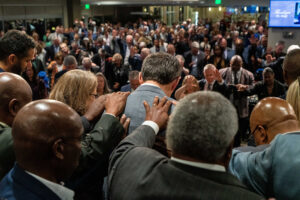
INDIANAPOLIS (BP)–The name of the first African American church to affiliate with the Southern Baptist Convention will be announced with the June publication of the Journal of African American Southern Baptist History.
Emerging just one year after its inaugural volume, the journal is published by the Black Southern Baptist Denominational Servant’s Network.
“This is a unique collection of information on the history of African American Southern Baptists,” said Sid Smith, executive director of the network and of the Florida Baptist Convention’s African American ministries division, as well as a noted researcher in the area of African Americans and Southern Baptists. “This journal is the only documentation of African American Southern Baptist history to be found today.”
Smith, who wrote the article on the first Southern Baptist African American church for the journal, will present his material at the annual meeting of the Denominational Servants Network, set for 6 p.m. Saturday, June 12, at Gabriel Missionary Baptist Church in Indianapolis.
The journal — with its distinctive cover that looks like Kinte cloth — will include at least nine other articles.
Among the authors are T. Vaughn Walker, Kevin Smith and Roy Cotton. Walker is professor and chairman of black church studies at Southern Baptist Theological Seminary in Louisville, Ky. Smith is Martin Luther King Jr. Fellow at Southern Seminary. Cotton is the Dallas/Fort Worth Metroplex regional consultant for the Baptist General Convention of Texas’ Church Multiplication Center.
Walker’s article “Cooperative Ministries: A History of Racial Reconciliation,” explores the history of racial reconciliation in the SBC from the perspective of cooperative ministries, which was an effort to reach out to black Baptist denominations. This was dropped in the 1980s (except in Kentucky) to focus attention and resources on planting distinctively African American churches, which resulted in more black churches but hurt relationships with National Baptists, Walker writes.
Smith’s article is titled, “Race, Class, and Gender in Early Progressive National Baptist Convention Rhetoric.” In it Smith examines how progressive social concern and issues of social upheaval affected black Baptists in the early 1960s, particularly focusing on Martin Luther King Jr. and Joseph H. Jackson, president of the National Baptist Convention. They disagreed over techniques to be used by blacks seeking equality. They also differed over gender and class (educational) issues.
Cotton’s article is a book review of “Growth Principles for an Exciting Church” by Howard E. Anderson Sr., pastor of the “Exciting” Singing Hills Baptist Church in Dallas. Cotton reviews several of the nine church health and growth principles of Anderson’s book, which relays practical insights while crossing cultural and social lines. The book has been recommended as a resource for denominational servants, church planters, pastors and leaders.
Subscription requests for the Journal of African American Southern Baptist History can be addressed to Smith in care of Black Denominational Servant’s Network, 6336 Wood Valley Road, Jacksonville FL 32217.
–30–















